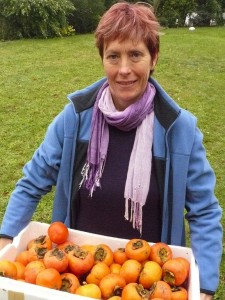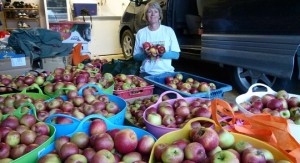Sharing the surplus of fruit in New Zealand
 The Community Fruit Harvest Initiative
The Community Fruit Harvest Initiative
© Kristina Jensen, August 2013
This winter, I was the lucky recipient of this huge box of persimmons. Every day for a week I had driven past and watched the tuis and blackbirds having a good old feast on the glowing orange orbs hanging from the bare branches. So carrying on my mother’s tradition of ‘waste not want not’, I gathered up my pluck and knocked on the door.
‘Hope you don’t think I’m being cheeky,’ I began (a mixture of humor, politeness and humility always helps as an introduction), ‘but I couldn’t help but notice that you have oodles of persimmons on your tree and I wondered if I could have some.’
I quickly added that I was willing to pay for them but the woman who stood in the doorway promptly insisted that I pick as many as I liked and waved me out to the garden with a box she happened to have handy. She added as I disappeared round the corner that she and her husband usually donated the lot to the hospital and that a local woman volunteered her time to come over and pick the fruit and transport it.
This got me thinking about surplus fruit and what could be done to distribute it to those in need. I didn’t have long to think about it before I had the good fortune to hear about Di Celliers, an Auckland woman who has helped to mobilize teams of volunteers all over New Zealand to harvest surplus fruit from those who simply have too much.
You are what you think: join Club Happyzine today and get your positive news download every Friday.
Di told me during our telephone interview that while driving around in the suburbs, she began to see trees laden with citrus fruit. At the time, she was involved in a community garden project with fruit trees being planted as part of the grand design.
However, it would be years before any fruit appeared on the trees. Meanwhile, lemons, grapefruit and other fruit were literally rotting on the ground in her own neighbourhood.
That was the ‘light bulb moment’ taken care of and now the Auckland Community Fruit Harvest Initiative supplies thousands of kilos of fruit for distribution to over 70 food banks and charities via the Auckland City Mission. And it doesn’t stop there. A dedicated team of marmalade and jam makers is on hand to process fruit into a readyto-use product, some of which is donated and the rest is sold to help pay for the sugar.
Di’s initial personal mission with the project was to connect mainly with the elderly, in whose gardens most of these trees grew. As the project gathered momentum, she saw the opportunity to encourage more ‘garden to table’ experiences for children who potentially receive the fruit in School Breakfast Club schemes and join their families to help with the harvest.
“Often fruit goes to waste when people are elderly or disabled and can’t pick fruit from their trees, or simply don’t want to,” says Di. “With so many people struggling to make ends meet, this is an satisfying way to help provide fresh fruit to those who really need it.” Over the past two years, Di has also been contacted by orchardists who want to share their fruit.
Di’s current role involves collating and managing a database of fruit trees that are available for picking, and organising volunteer pickers when the fruit is ripe. She will supply anyone who is keen to start the initiative in their own area with media contacts, a flyer template, a start-up document outlining all the necessary ‘need-to-knows’, the official Community Fruit Harvest Initiative logo and nationwide website promotion.
Jeremy Briggs, the co-ordinator of the Waikato group encourages people to start at a level that suits their lifestyle demands. “Co-ordinators can choose to start small by picking fruit in their street or through their school, church or other group,” he says.
“Or if they have more time, they can manage a suburb or larger area. Every bit helps.”
At the close of our conversation, I learned something about Di’s group that truly warmed my heart. One of the many preserves that her group makes in large quantities is lemon cordial. My own dearly departed mother was a great producer of lemon cordial, both at home, and on a community level and I continue making her recipe to this day. No function passed by without large refreshing jugs of Mum’s lemon cordial to quench our thirst. So I share the recipe with you now as a tribute both to my mum and to Di and her inspiring idea.
To find out more, please contact Di Celliers directly at [email protected].
Check out the website to find more information about other areas in New Zealand:
http://www.pickfruit.co.nz/
Like this project on Facebook: https://www.facebook.com/pickfruit
Lemon Cordial Recipe
I honestly cannot remember a time in my childhood when I didn’t drink this cordial.
My mother made it for every function in our community: scouts, school outings, you name it, she provided the cordial. Growing up on a farm, my brother and I gratefully gulped down gallons of this refreshing drink after haymaking and milking cows in summer. It looks super decorated with ice and mint leaves, and is equally hearty served hot on a chilly winter’s day.
3 lemons, washed and peeled
3 cups of sugar
3 cups of water
Citric acid as a preservative and vitamin C enhancer
Put the lemon peel, sugar and water into a saucepan.
Bring to the boil, stirring so the sugar does not burn.
Simmer gently for 20 minutes then allow to cool completely.
Add the pulp and the juice of the fruit and 1 tsp of citric acid.
Strain though a sieve and bottle.
Refrigerate.
Keeps for up to 3 months.
To use, pour a small amount into a glass and add hot or cold water to taste.
For an additional zing;
Slice 6 thin wafers of fresh ginger in to the saucepan at the boiling stage.
Using Less Sugar:
To make the cordial stronger, use more fruit and less sugar. However, it doesn’t last as long.
Using Honey:
This cordial also tastes delicious when made with honey. Use liquid honey; ½ cup of honey to each lemon and cup of water.
loading...
loading...



Very inspiring Kristina – great to hear that people are making use of all the fruit out there!
I did this before with a beautiful laden lemon tree at a flat inhabited by a bunch of students. I am not sure they had even noticed it was there. I knocked on their door and offered them some change I had in the car and took a large bag of fresh and yummy lemons. The type you can eat straight if you like!
I made good use of them with drinks, puddings and squeezed on a stir fry.
Thanks for sharing xx
loading...
loading...